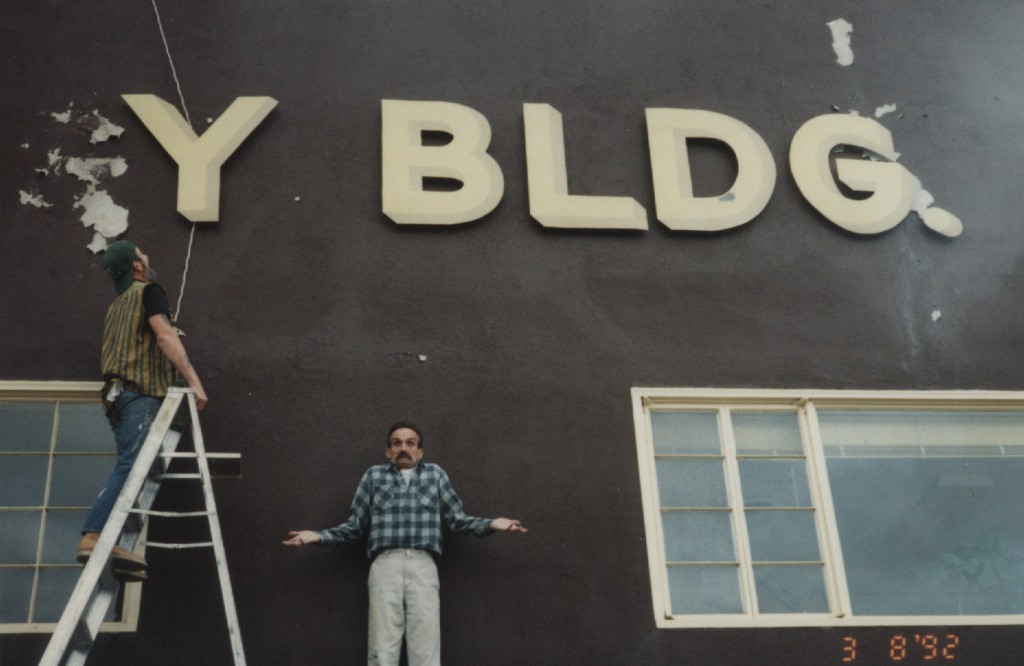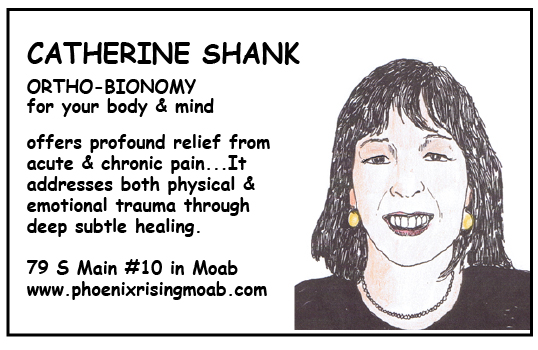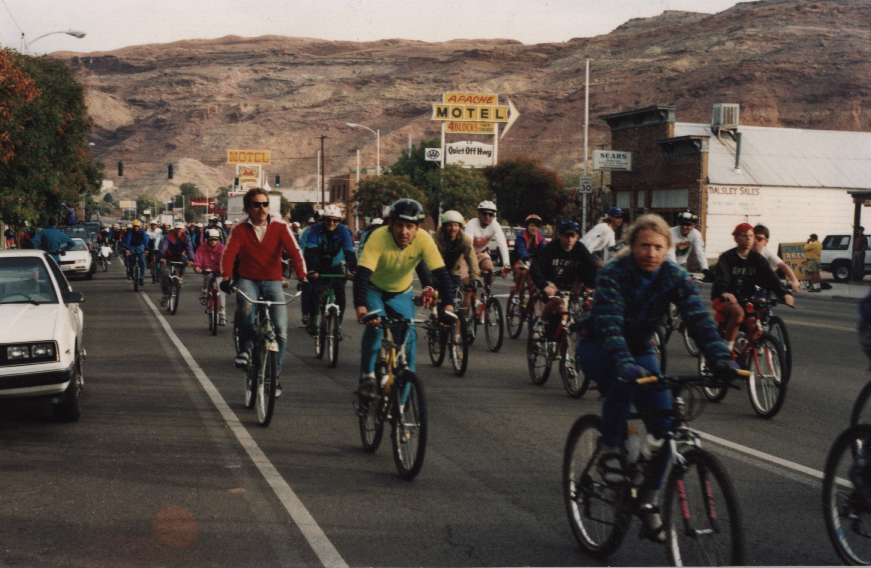
EDITOR’S NOTE: For Part One of: ‘The Calm before the Swarm,” go to:
http://www.
After decades in operation, the Atlas Uranium Mill, once the lifeblood of the community, ground to a halt, closed in 1984 and never re-opened. The domestic uranium industry had collapsed in the wake of the Three Mile Island accident; then the nuclear disaster at Chernoble, in 1986, drove nuclear power even deeper into the ground. Hundreds of Grand County citizens were suddenly jobless and the ripple effect was felt across all strata of the Moab economy. Almost overnight, the “Uranium Capital of the World” became a ghost town with as many as a quarter of its homes for sale and many Main Street businesses boarded up. Prices plummeted.
For the marginal Moabites who had come here solely to live near the canyon country and who had survived by cobbling together a strange and varied assortment of jobs, we became the new prospective home buyers. Even I, a lowly seasonal ranger at Arches National Park, could afford to buy a small cottage on Locust Lane. Suddenly and unexpectedly, we became the new stalwart citizens.
But how would we survive? The toxic waster incinerator proposed by the Grand County commissioners went down in flames after its citizens overwhelmingly voted ‘NO’ in a county referendum. Tourism was always there and had been for decades, but few of us thought it could be THE solution to our economic woes. But then again, we thought, maybe all we needed was a part-time economy.
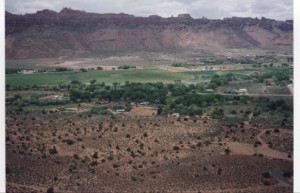 For a short while—and maybe this is just me being more delusional than usual—it looked as if Moab might become something very different. There was the germ of an idea that perhaps we had something special here, and that it had very little to do with money or the quest for material wealth.
For a short while—and maybe this is just me being more delusional than usual—it looked as if Moab might become something very different. There was the germ of an idea that perhaps we had something special here, and that it had very little to do with money or the quest for material wealth.
We lived in Moab, Utah. We were already rich. Who needed more than the real wealth that this amazing red rock country had already bestowed upon us? We just wanted to make enough money to live happily and humbly ever after.
Many of us created our own businesses in those days. Most of them had a tourist-related connection. Some new locally owned restaurants and cafes opened—places like ‘Honest Ozzie’s and ‘Back to the Soda Fountain’ and the ‘Center Café.’
Kathy Cooney and Chuck Schildt opened the Moab mercantile art gallery and Vern Erb started the Hogan Trading Company. Both businesses were in the Grand Emporium building on Main St. (Now the Slickrock Café. New businesses opened on Main. Rent was still cheap and Moab’s last standing citizens were feeling creative.
Kyle and Carrie Bailey opened a video rental shop on Center Street. Tim and Terry and Becky Knouff—The Flying Knouff Family!— started ‘K Group.’ They advertised themselves as “house painters/illusionists….seldom seen but rarely forgotten.”
I was looking for a way to stay in Moab too. I’d quit the Park Service in 1986 and needed to find a way to make a living. I came up with The Zephyr in late 1988. I strong-armed about fifty friends and relatives to buy $10 subscriptions and I strung together about 25 advertisers who were willing to pay in advance, sight unseen, for their first ad so I could pay the printer.
Much of my ‘income’ came from trade-outs. In the late 1980s, Moab was the Barter Capital of SE Utah. There just wasn’t that much cash flowing and so I took my ad payments from the Main Street Broiler in the form of cheeseburgers and buttermilk pancakes. I traded with Petra Computers for a desktop and a laser printer and free advice. The Cowboy Trading Company kept me well-attired and Dave’s Corner Market kept a cup in the backroom for my endless coffee fix.
Life was good.
And yet, even from the beginning, we should have seen what was coming. It’s almost impossible to hide from the Great American Entrpreneurial Spirit. Moab was no different. Something had happened here a few years earlier that sealed our fate and we were foolish to think we could escape its greedy clutches. This is how it all went down…

One day in 1984, Kris Allen and Bill Davis stopped by Arches to say hello. Both had lived in Moab for years but had recently moved to California. Now they were back here as tourists; strapped to the back of Bill’s truck were two bicycles, unremarkable in most respects except they sported knobby tires and thicker frames. Kris explained that they were “mountain bikes” and both believed that these bikes would revolutionize recreation in the canyon country.
“What do you mean, ‘revolutionize,’” I asked.
“Mountain bikes can go anywhere,” Bill said. “Anyplace a jeep can go, a mountain bike can go. And they’re cheaper to run, I might add.”
“Yeah,” I said uncertainly. “Maybe they can go anywhere, but jeepers aren’t going to give up their 4WDs for a bike.”
“Maybe not the jeepers, but there’s a market for this, believe me.”
I thought they were both mad. I remembered what a local rancher, Don Holyoak, had once said about the sport of bicycling: “Oh yeah, that’s where you pedal your legs off to give your ass a ride…I’ll keep my horse.” The thought of mountain bikes swarming over my beloved slickrock like frenzied ants on a hot day disturbed me in a deep and profound way. But the idea seemed fantastic and I dismissed their prophesies with an uneasy smile. Bill and Kris climbed back in their Four-Runner and drove up the old highway for a premier ride on their mountain bikes.
Kris and Bill were early bike afficionados in Moab but they weren’t the first—-not quite. The idea that Moab could become the “Mountain Bike Capital of the World” first occurred to a most unlikely pair of brothers from Moab. They had both been laid off recently from the uranium industry and their names were Bill and Robin Groff.
Big Bill and Little Robin don’t look like bikers. If they were riding Harleys, perched atop a Chopper and decked out in
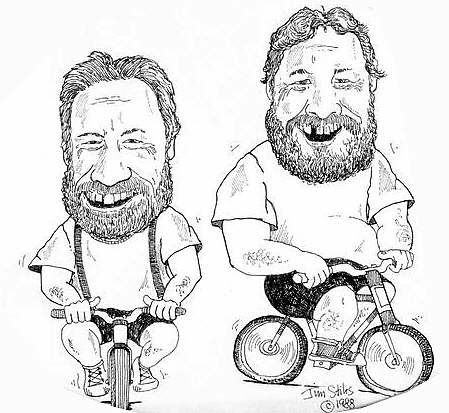 black leathers, that might suit a newcomer’s first vision of the Groffs on a two-wheeled conveyance. They’re big fellows with heads like hairy cinder blocks. Their wrists are as big as my thighs. A couple of Blutos might best describe them…Blutos who eat spinach. They take shit from no one.
black leathers, that might suit a newcomer’s first vision of the Groffs on a two-wheeled conveyance. They’re big fellows with heads like hairy cinder blocks. Their wrists are as big as my thighs. A couple of Blutos might best describe them…Blutos who eat spinach. They take shit from no one.And maybe that’s why nobody had the nerve to advise them not to open a bike and outdoor gear shop in the fall of 1983. Which is what they did. At first they only sold road bikes; in fact, not many biking options existed, but they’d heard of the newly arrived sport of “mountain biking,” and one day, a mystery biker known only as “Scott” appeared at their shop door. He had pedaled all the way from Santa Barbara, California on what the Rim boys called “a precursor to the modern-day mountain bike.” It was a modified 5-speed Ross, one of the early popular bike brand names and soon the Groffs were Ross dealers. By the fall of 1983 they were also selling a bike called the “Stumpjumper” from a company called Specialized.
Robin put the new bikes through their paces, learning just what their capabilities were and even helped herd cattle on them with his rancher buddy Deuce. It occurred to them that mountain biking could draw thousands of enthusiasts to the canyon country if they could just show them the many venues that were available. Robin scouted the backcountry for suitable trails and routes and there were plenty of them. The remnants of old jeep trails from the Uranium Days were about to be revived. Old two-tracks would allow bicyclists to ride side-by-side through some of the most remarkable scenery on earth.
But more than anything else there was the slickrock, the local name given to the vast expanses of raw hard sandstone that sometimes stretch for miles without interruption. The domes and channels and turrets and arches and canyons provided every kind of recreational challenge imaginable for a hard core mountain biker. And the most extraordinary slickrock challenge already carried the name….
The Slickrock Bike Trail was actually created by dirt bikers, the motorized predecessors to the pedal-powered Stumpjumpers. Though the trail had received some early notoriety when it was first built on BLM lands above Moab along the Sand Flats, it had recently fallen into disuse. Robin and a friend named Dan Hosco decided to test their bikes on the Slickrock Trail….lights came on inside their heads. This was it.
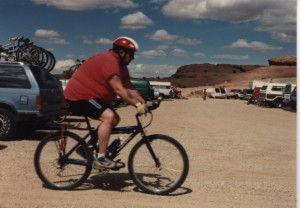 By the following spring Rim began renting bikes and had teamed up with a new arrival, a tall lanky man named John Groo. The Groffs and Groo created Rim Tours and led small excursions into the backcountry around Moab. Bike touring started slowly and early on; even one paying customer was enough to load up the bikes into an old pickup truck called “Old Green” and head for the trail.
By the following spring Rim began renting bikes and had teamed up with a new arrival, a tall lanky man named John Groo. The Groffs and Groo created Rim Tours and led small excursions into the backcountry around Moab. Bike touring started slowly and early on; even one paying customer was enough to load up the bikes into an old pickup truck called “Old Green” and head for the trail.Then, as it almost always happens, Forces in the Universe that are far beyond our power to comprehend came together to create a recreational revolution. National Geographic was in Moab and its photographer, Ken Redd, was shooting images of the spectacular red rocks when he began to notice the bicyclists. When the story appeared with a comment and several photos of the newly arrived sport of mountain biking, an avid biker from Crested Butte, Colorado named Hank Barlow took note. In fact he did more than that.
Barlow had come to Colorado from Marin County, California, the place many call the Birthplace of Mountain Biking. Barlow and a group of fellow bikers had played with the idea of a magazine devoted entirely to the sport of mountain biking and they wanted something extraordinary for its first issue. One glance at the pages of National Geographic convinced Barlow that Moab was the place.
“Mountain Bike” appeared on newsstands a few months later but in it, the bicycles played second fiddle to the incredible scenic backdrop–Moab dominated the first edition. Soon all roads led to Moab. The town and the surrounding countryside exploded. According to the Rim Guys: “It is said that in the realm of mountain biking, Crested Butte provided the ‘spirit’, Marin County provided the ‘tools’, and Moab provided the ‘place.’ The triad was complete, mountain biking had arrived and Rim Cyclery was in the thick of it.”A year later, in the autumn of 1986, Rim Cyclery sponsored the first “Canyonlands Fat Tire Festival.” Thousands of bikers arrived to experience the Slick Rock Bike Trail for the first time…it was already “world famous” by the time their knobbies touched the rock. People began to refer to the mountain bike influx as a phenomenom.
For a town that, just a few years earlier, had proclaimed itself “The Uranium Capital of the World,” Moabites were utterly bewildered. This was the community that had been settled by ranchers a century earlier, and that had been one of the most remote, backwater towns in America until Charlie Steen put Moab on the map in the 50s. For the last 40 years it had flourished or failed on the whims of the mining industry and no one imagined straying from that course, for better or worse. The men and women who lived here were predominantly conservative, hard-working, and not prone to “non-motorized recreation” (an expression not quite in the lexicon in the late 80s) for its own sake. Recreation meant a day of four-wheeling while checking claims or fence lines. And other than Jeep Safari and maybe hunting season, Moabites rarely saw a gathering of anyone for a single event.
The 1986 Fat Tire Festival in late October changed that.
Winter settled over Moab just a few days after the Festival, the Big Tree on First South shed its leaves again, as it had each winter for over a century, the skies turned grey, we retrieved our regular seats at the local diners and for all appearances, our little town had returned to “normal.” But there was an anticipation throughout those cold months…changes were coming that would affect our lives and our community forever. There was almost an inevitability about it. A nebulous sense of Doom. We fired up our wood stoves and sipped our coffee and waited for Spring.
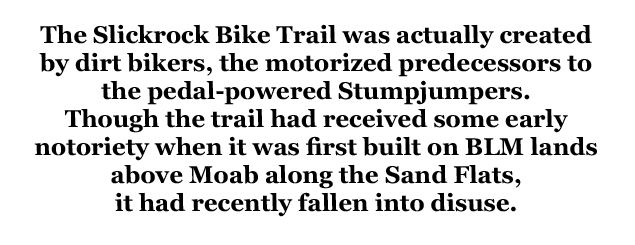 I have always associated the coming of Spring with color—-those brilliant bursts of pigment that celebrate the departure of grim, dull days and the silhouettes of skeletal trees and matted dead leaves and breath we can see. In Moab, winter can be especially cruel. Mild autumn weather often lingers into November and we become seduced by the notion that maybe Winter will simply pass us by this year. When it brutally and suddenly appears, we are that much more unprepared to accept the bitter months ahead.
I have always associated the coming of Spring with color—-those brilliant bursts of pigment that celebrate the departure of grim, dull days and the silhouettes of skeletal trees and matted dead leaves and breath we can see. In Moab, winter can be especially cruel. Mild autumn weather often lingers into November and we become seduced by the notion that maybe Winter will simply pass us by this year. When it brutally and suddenly appears, we are that much more unprepared to accept the bitter months ahead.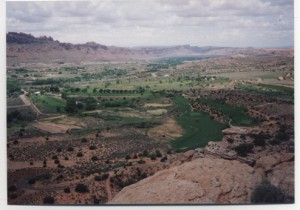 Moab’s winters were exacerbated by its location and its bad habits. There is no more spectacular setting for a town than Moab–it lies between towering red sandstone cliffs. The West Wall rises more than 2000 feet above the Colorado River and to the east, broken ledges and cliffs lead to the Sand Flats and into the high country of the La Sal Mountains. But winter inversions love deep canyon towns like Moab. Under normal conditions, the temperature drops as you travel to higher elevations. Inversions, as the name suggests, turn logic on its head. Then factor in the smoke from the wood fires that most Moabites used then to heat their homes and the acrid smoke that used to pour from the Atlas Mill, north of town, and the air was as foul as anything found in Akron or Pittsburgh. Driving into town from Arches, our nostrils could detect the shift from Atlas smoke to wood smoke, just as we passed the Grand Old Ranch House. Wood smoke, by comparison, smelled healthier.
Moab’s winters were exacerbated by its location and its bad habits. There is no more spectacular setting for a town than Moab–it lies between towering red sandstone cliffs. The West Wall rises more than 2000 feet above the Colorado River and to the east, broken ledges and cliffs lead to the Sand Flats and into the high country of the La Sal Mountains. But winter inversions love deep canyon towns like Moab. Under normal conditions, the temperature drops as you travel to higher elevations. Inversions, as the name suggests, turn logic on its head. Then factor in the smoke from the wood fires that most Moabites used then to heat their homes and the acrid smoke that used to pour from the Atlas Mill, north of town, and the air was as foul as anything found in Akron or Pittsburgh. Driving into town from Arches, our nostrils could detect the shift from Atlas smoke to wood smoke, just as we passed the Grand Old Ranch House. Wood smoke, by comparison, smelled healthier.And so, enduring all that, we’d wait for Spring with unbridled anticipation. Looking for color.
The Colors of Spring. Like the iridescent glow of a mountain blue bird, skimming across the sagebrush meadow near Sand Dune Arch. Or perhaps the first gaudy splash of Indian paintbrush, poking through the rocks in Hidden Valley. And around town, the careful study of Golden Willows for a hint of green— always a good harbinger of Spring.
But this year, the Color of Spring assumed an entirely new meaning.
I can still remember where I was—-eating breakfast at the Main Street Broiler, homemade sourdough biscuits and fresh creamery butter if I recall, when Carl Rappe, the Broiler’s soul proprietor, leaped from his seat and dashed out the door. He pointed toward Kane Creek Blvd with a trembling finger and shouted, “They’re here! They’re here!”
It was the color I saw first. A hue so vivid and alive, it almost hurt to look at it. But it wasn’t the lupines that we’d longed to see, or a hint of violets, or even the locoweed that grew so prolifically along the roadsides. This was something else…
It was a herd, a flock…a rash perhaps, of mountain bikers, dressed in matching royal-blue, skin-tight Lycra riding outfits. From my vantage point, they looked to me like a cluster of naked blue people.
Aliens, I thought…we’ve been invaded. Which in a sense was true. With hordes of naked blue aliens pedaling the streets and alleys of our quaint little backwater town, could Judgement Day be far behind?
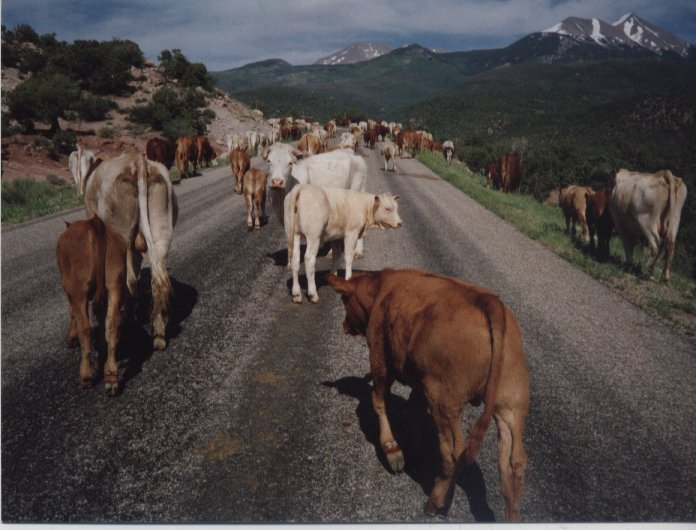 NEXT TIME: The last installment of this three part series:
NEXT TIME: The last installment of this three part series:“What can we steal today?”
NOTE: Part of this story is an excerpt from “BRAVE NEW WEST. To order a signed copy, go to our home page.

